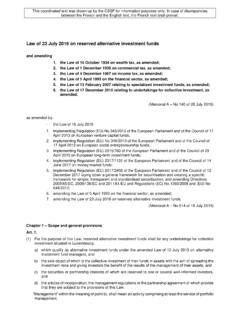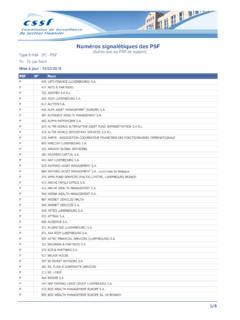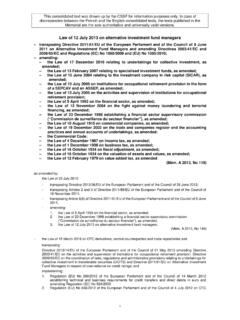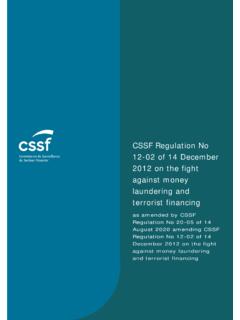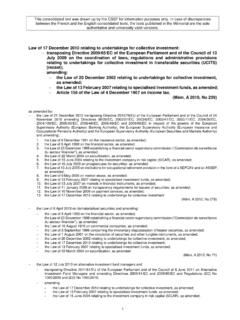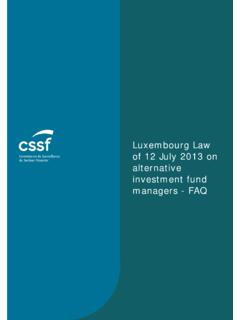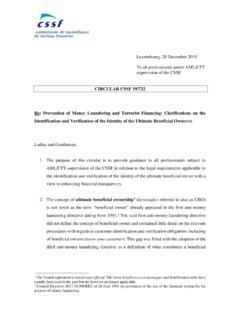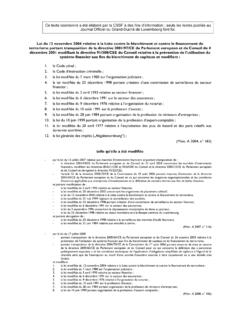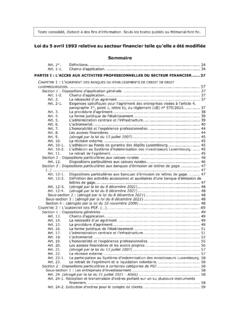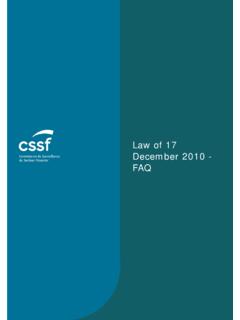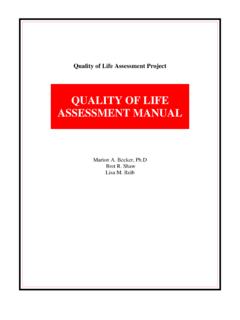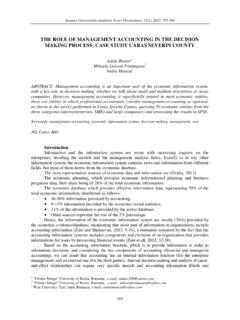Transcription of Circular CSSF 12/552
1 Circular CSSF 12/552 as amended by Circulars CSSF 13/563, CSSF 14/597, CSSF 16/642, CSSF 16/647, CSSF 17/655, CSSF 20/750, CSSF 20/759 and CSSF 21/785 1/82 Circular CSSF 12/552 as amended by Circulars CSSF 13/563, CSSF 14/597, CSSF 16/642, CSSF 16/647, CSSF 17/655, CSSF 20/750, CSSF 20/759 and CSSF 21/785 CENTRAL ADMINISTRATION, INTERNAL GOVERNANCE AND RISK MANAGEMENT Circular CSSF 12/552 as amended by Circulars CSSF 13/563, CSSF 14/597, CSSF 16/642, CSSF 16/647, CSSF 17/655, CSSF 20/750, CSSF 20/759 and CSSF 21/785 2/82 Circular CSSF 12/552 as amended by Circulars CSSF 13/563, CSSF 14/597, CSSF 16/642, CSSF 16/647, CSSF 17/655, CSSF 20/750, CSSF 20/759 and CSSF 21/785 Re: Central administration, internal governance and risk management1 Ladies and Gentlemen, Articles 5(1a) and 38-1 of the Law of 5 April 1993 on the financial sector ( LFS ), supplemented by Regulation CSSF No 15-02 relating to the supervisory review and evaluation ( RCSSF 15-02 ) require credit institutions to have robust internal governance arrangements, which shall include a clear organisational structure with well-defined, transparent and consistent lines of responsibility, effective processes to identify, manage, monitor and report the risks to which they are or might be exposed, adequate internal control mechanisms, including sound administrative and accounting procedures and remuneration policies and practices allowing and promoting sound and effective risk management, as well as control and security mechanisms for their IT systems.
2 This Circular specifies the measures credit institutions must take pursuant to the provisions of the LFS and RCSSF 15-02 as regards central administration, internal governance and risk management. It reflects the European and international principles, guidelines and recommendations which apply in this respect, translating them, in a proportionate way, in the context of the Luxembourg banking sector. Where, due to the size, the nature and the complexity of the activities and the organisation, the application of the principle of proportionality requires enhanced central administration, internal governance or risk management, the credit institutions shall refer to the principles set out in Chapter 2 of Part I and to the guidelines and recommendations listed in Part IV of this Circular for guidance on this implementation. This concerns especially the European Banking Authority ( EBA ) Guidelines on internal governance (EBA/GL/2017/11) and the joint EBA and the European Securities and Markets Authority ( ESMA ) Guidelines on the assessment of the suitability of members of the management body and key function holders (EBA/GL/2017/12).
3 The principles and good practices arising from other sources already included in the previous versions of the Circular have been maintained in so far as they have not become obsolete. 1 To professionals performing lending operations as defined in Article 28-4 of the Law of 5 April 1993 on the financial sector, Chapter 3 of Part III, with the exception of Sub-chapter Exposures associated with particularly high risk shall apply. Chapter 2(12) of Part III shall also apply. Luxembourg, 7 December 2020 To all credit institutions and professionals performing lending operations1 In case of discrepancies between the french and the English text, the french text shall prevail. Circular CSSF 12/552 as amended by Circulars CSSF 13/563, CSSF 14/597, CSSF 16/642, CSSF 16/647, CSSF 17/655, CSSF 20/750, CSSF 20/759 and CSSF 21/785 3/82 As regards the appointments of members of the management body and key function holders, this Circular should be read in conjunction with the Prudential Procedure in this respect published on the CSSF website.
4 The Circular is divided into four parts: the first part establishes the scope, the second part is dedicated to central administration and internal governance requirements, the third part covers specific risk management requirements and the fourth part provides for the entry into force and the history of the updates, allowing the reader to retrace the amendments entailed by the successive updates. Circular CSSF 12/552 as amended by Circulars CSSF 13/563, CSSF 14/597, CSSF 16/642, CSSF 16/647, CSSF 17/655, CSSF 20/750, CSSF 20/759 and CSSF 21/785 4/82 TABLE OF CONTENTS Part I - Definitions and Scope 7 Chapter 1. Definitions and abbreviations 7 Chapter 2. Scope and proportionality 9 Part II. Central administration and internal governance arrangements 11 Chapter 1. Central administration 11 Chapter 2. Internal governance arrangements 11 Chapter 3.
5 General characteristics of robust central administration and internal governance arrangements 13 Chapter 4. Supervisory body and authorised management 14 Sub-chapter Supervisory body 14 Section Responsibilities of the supervisory body 14 Section Composition and qualification of the supervisory body 18 Section Organisation and functioning of the supervisory body 19 Section Specialised committees 20 Sub-section Audit committee 22 Sub-section Risk committee 23 Sub-chapter Authorised management 25 Section Responsibilities of the authorised management 25 Section Qualification of the authorised management 29 Chapter 5. Administrative, accounting and IT organisation 29 Sub-chapter Organisation chart and human resources 29 Sub-chapter Procedures and internal documentation 30 Sub-chapter Administrative and technical infrastructure 31 Section Administrative infrastructure of the business functions 31 Section Financial and accounting function 32 Section IT function 34 Section Communication and internal and external alert arrangements 34 Section Crisis management arrangements 35 Chapter 6.
6 Internal control 35 Sub-chapter Operational controls 36 Section Day-to-day controls carried out by the operating staff 36 Section Ongoing critical controls 36 Section Controls carried out by the members of the authorised management on the activities or functions which fall under their direct responsibility 37 Sub-chapter Internal control functions 38 Circular CSSF 12/552 as amended by Circulars CSSF 13/563, CSSF 14/597, CSSF 16/642, CSSF 16/647, CSSF 17/655, CSSF 20/750, CSSF 20/759 and CSSF 21/785 5/82 Section General responsibilities of the internal control functions 38 Section Characteristics of the internal control functions 39 Section Execution of the internal control functions' work 40 Section Organisation of the internal control functions 41 Section Risk control function 45 Sub-section Scope and specific responsibilities of the risk control function 45 Sub-section Organisation of the risk control function 47 Section Compliance function 48 Sub-section Compliance charter 48 Sub-section Scope and specific responsibilities of the compliance function 49 Sub-section Organisation of the compliance function 51 Section Internal audit function 51 Sub-section Internal audit charter 51 Sub-section Specific responsibilities and scope of the internal audit function 53
7 Sub-section Execution of the internal audit work 54 Sub-section Organisation of the internal audit function 55 Chapter 7. Specific requirements 56 Sub-chapter Organisational structure and legal entities (Know-your-structure) 56 Section Complex structures and non-standard or potentially non-transparent activities 56 Sub-chapter Management of conflicts of interest 57 Section Specific requirements relating to conflicts of interest involving related parties 58 Sub-chapter New Product Approval Process 59 Sub-chapter Outsourcing 59 Section General outsourcing requirements 60 Section Specific IT outsourcing requirements 63 Sub-section IT system management/operation services 63 Sub-section Consulting, development and maintenance services 64 Sub-section Hosting services and infrastructure ownership 64 Circular CSSF 12/552 as amended by Circulars CSSF 13/563, CSSF 14/597, CSSF 16/642, CSSF 16/647, CSSF 17/655, CSSF 20/750, CSSF 20/759 and CSSF 21/785 6/82 Section Additional general requirements 65 Section Documentation 66 Chapter 8.
8 Legal reporting 67 Part III. Risk management 67 Chapter 1. General principles as regards risk measurement and risk management 67 Sub-chapter Institution-wide risk management framework 67 Section General information 67 Section Specific (risk, capital and liquidity) policies 67 Section Risk identification, management, measurement and reporting 69 Chapter 2. Concentration risk 69 Chapter 3. Credit risk 70 Sub-chapter General principles 70 Sub-chapter Residential real estate mortgage credit to individuals 71 Sub-chapter Credits to real estate developers 71 Sub-chapter Exposures associated with particularly high risk 72 Sub-chapter Non-performing and forborne exposures 72 Chapter 4. Risk transfer pricing 73 Chapter 5. Private wealth management ( private banking ) 74 Chapter 6. Exposures to shadow banking entities 75 Sub-chapter Implementation of sound internal control principles 75 Sub-chapter Application of quantitative limits 75 Chapter 7.
9 Asset encumbrance 77 Chapter 8. Interest rate risk 77 Sub-chapter Interest rate risk arising from non-trading book activities 77 Sub-chapter Corrections to modified duration for debt instruments 78 Chapter 9. Risks associated with the custody of financial assets by third parties 78 Part IV. Chronology 78 Circular CSSF 12/552 as amended by Circulars CSSF 13/563, CSSF 14/597, CSSF 16/642, CSSF 16/647, CSSF 17/655, CSSF 20/750, CSSF 20/759 and CSSF 21/785 7/82 1. Part I - Definitions and Scope Chapter 1. Definitions and abbreviations 1. For the purposes of this Circular : 1) competent authority shall mean the European Central Bank ( ECB ) for significant credit institutions ( significant institutions , SI ) or the Commission de Surveillance du Secteur Financier ( CSSF ) for less significant credit institutions ( less significant institutions , LSI )2 and branches established in Luxembourg of third-country credit institutions.
10 Moreover, as host authority of Luxembourg branches of credit institutions authorised in another Member State, the CSSF retains the responsibility for the oversight of certain areas outside the banking prudential supervision, the fight against money laundering and terrorist financing, the rules applicable to the provision of investment services and the enforcement of the requirements applicable to Luxembourg UCI depositaries. 2) authorised management or authorised managers shall be deemed the management body in its management function in accordance with the EBA Guidelines on internal governance ( EBA/GL/2017/11 ). The authorised managers shall be the persons referred to in Article 7(2) of the LFS and the senior management as defined in Article 3 of CRD IV. From a prudential standpoint, the authorised management shall be in charge of the day-to-day management of an institution, in accordance with the strategic directions and the key policies approved by the supervisory body.
